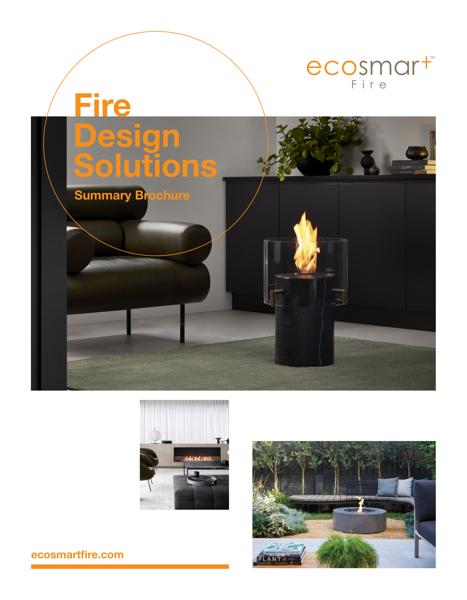Loading image...


Create an instant talking point
Because bioethanol is clean-burning, EcoSmart Fire models do not need a chimney or a flue, or a utility connection – offering the ultimate in design simplicity and flexibility.
Whether you're creating a custom fireplace feature, renovating an existing fireplace, or looking for an out-of-the-box solution, we have an ethanol fireplace to suit your needs.
You May Also Like
Learn More
Ethanol Fireplaces
Ventless Fireplaces
FAQ's
Will my ethanol fireplace heat the room?
All EcoSmart Fires are ventless, meaning all the heat stays in the room rather than escaping up a flue. Increased heat retention means increased fuel efficiency and a better chance of staying warm. While providing warmth, EcoSmart Fires are not designed to be used as a room’s primary heat source. Please see the burner section in our manual for full details.
What is bioethanol fuel made from?
Bioethanol fuel is made from plant sugars, particularly sugarcane, through fermentation and distillation processes. This renewable, plant-based fuel source is produced from agricultural by-products, creating a sustainable and carbon-neutral energy solution. The clean-burning bioethanol produces only heat, steam, and minimal carbon dioxide during combustion.
Can you cook on a bioethanol fireplace?
No, you cannot cook on a bioethanol fireplace. Bioethanol fireplaces are classified as decorative appliances intended for occasional use only, not for heating or cooking. They're designed to create ambience safely, but lack the proper heat distribution, surface design, and safety features required for food preparation.
Can ventless fireplaces cause moisture problems?
Yes, ventless ethanol fireplaces can cause moisture problems if used in poorly ventilated spaces. Ethanol combustion produces water vapour, which requires adequate room ventilation to prevent condensation and indoor air quality issues. Ensure proper air circulation and follow minimum room size requirements.
Can I convert my existing fireplace to bioethanol?
Yes, you can easily convert your existing fireplace to bioethanol using EcoSmart's VB2 burner, Heritage Grates, or Fireplace Grates. These products transform traditional wood-burning fireplaces into clean-burning bioethanol fires within minutes. Just ensure any gas connections are professionally disconnected first for safety.
Can I extinguish the ethanol fireplace before the fuel has burnt?
Yes, you can turn your EcoSmart Fire burner off at any given time, even if there is ethanol still left in the burner. It is recommended however, that you leave it to burn until it completely runs out. The shut-off mechanism is there for security and safety for those times when you need to leave the house, as it is not safe to leave a fire unattended. Please wait 60 minutes before relighting the ethanol after extinguishing it to let the ethanol cool. Built-up vapours may cause a strong, initial ignition if the ethanol has not cooled long enough.For all other brands, refer to the manufacturer's instructions.
How do ethanol fireplaces work?
EcoSmart Fire’s ethanol fireplaces are self-contained, burning bioethanol fuel that is housed within the stainless steel container. A flame regulator controls and stabilizes the flame. With a designated filling area, and easy shut-off mechanism, you can ignite the flame and turn it off in a matter of seconds.View this quick demonstration video to help illustrate the process.
https://youtu.be/OH5uFuAJ2Hg
Where is the best place to install an ethanol fireplace?
Our ethanol fireplaces can be installed virtually anywhere - in walls, cabinets, high-rise buildings, commercial/residential /hospitality spaces, indoors and outdoors. Because EcoSmart Fire’s ethanol fireplaces are ventless, they require no gas line, no electricity, and no chimney for a hassle-free and cost-effective installation. Our ethanol fireplaces have been designed and tested with safety as our top priority. We have outlined requirements for each ethanol burner, ethanol fireplace insert, and ethanol freestanding fireplace in our collection. These guidelines include minimum room size requirements and clearance recommendations for flammable materials and movable objects.Please refer to our manual for more information.
Is the ethanol fireplace heat output similar to a gas heater?
Burning bioethanol is similar to gas, but the room doesn't dry out as it does with gas - a more gentle, softer heat is created. Heat-wise, it depends on the models being compared. Some of our bioethanol burners output 15,000 BTU and can heat up to 60sqm of living space. Bioethanol is not, however, on an adjustable thermostat. Some may be turned up and down, but you can't control the room temperature in the same way as you do with gas on mains.
What are the pros and cons of ventless fireplaces?
Ventless ethanol fireplaces provide outstanding installation flexibility, requiring no chimney, flue, or fixed utility connection—making them ideal for apartments and contemporary interiors. They burn bioethanol cleanly, emitting no smoke, soot, or ash. However, as they consume oxygen during operation, it is essential to ensure proper ventilation in the room to prevent indoor air pollution. Always follow the minimum room size and ventilation guidelines specified by the manufacturer. These fireplaces are designed for decorative or supplemental heating, not as a primary heat source.



























